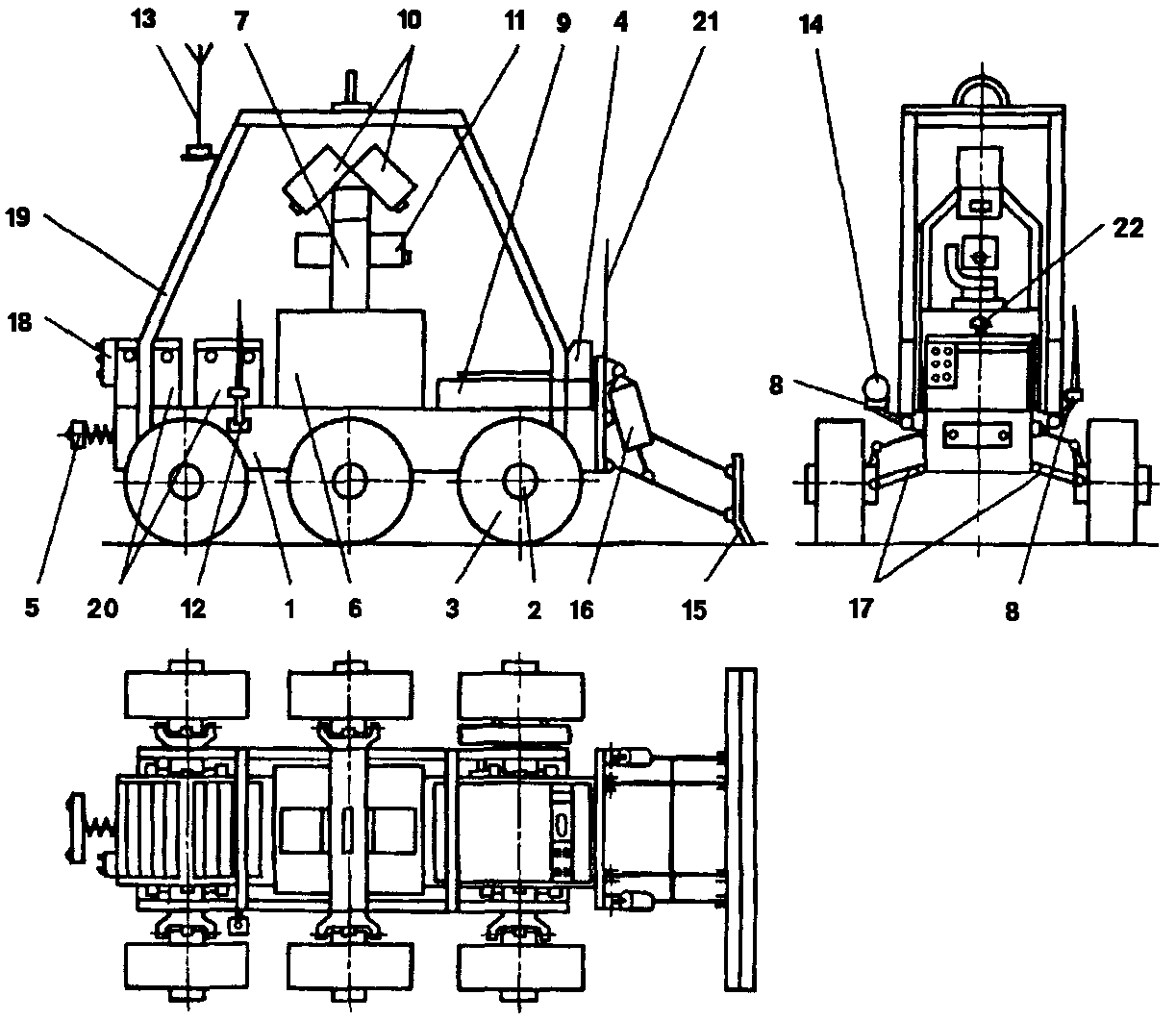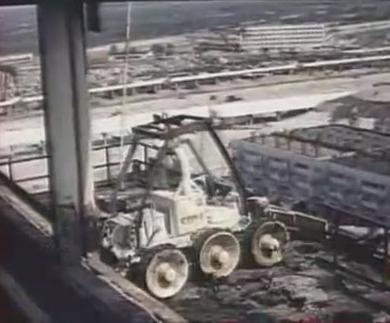The tragic events at Chernobyl nuclear power plant in April 1986 in USSR [1-5] caused the need of the urgent creation of unmanned robotic vehicles with remote control. Such specialized transport robots (STR) have been created by VNIItransmash on the basis of experience at developing and testing of “Lunokhod-1” and experimental models of planetary rovers. They have been used for clearing and deactivation of roofs of the third power-generation unit of Chernobyl nuclear power plant in zone of high radiation.[9]
As ascertained by the commission for investigation the causes of the disaster, it has been connected with the unacceptably high superheating of water and gases in confined spaces and technological systems of the reactor and it was not a nuclear explosion. However, the explosion opened the reactor and scattered the radioactive fuel elements (fuel rods), and also graphite stack, heat pipe channels and other elements of the power and building constructions that took various doses of radiation. The area with the diameter of about 30 km has been declared by the danger zone. Inhabitants were evacuated from there and decontamination works were deployed. Carrying out these activities has required the use of the various remote-controlled devices.[9]
Using of STR-1. [12]
Specialized transport robots are the main part of the robotics complex, designed to clear blockages, remove products of accident release and radioactive contaminated materials in areas that are inaccessible for long-term work of people, in particular, on the roofs of buildings and structures of the station. Besides the transport robots, the robotic system includes the following:
1) Device for transporting the robot and recharging its power source;
2) The stationary review camera with cable nodes and masts;
3) Video control device of the stationary and onboard telesystems with cable nodes and receiving TV antennas;
4) Remote control – transmitter with a transmitting radio antenna;
5) Stationary charge-discharge unit with a cable;
6) Stationary equipment for deactivation of the undercarriage.
The complex was fully created on the basis of the Soviet developments and products which were mastered by local industry. The mobile robot of this complex were designed and created in a very short time (less than two months) only because of technological advance, accumulated during the scientific researches and developments for creation of planetary rovers for various space programs. In the period from 8 August to 10 October 1986 various works were carried out with help of STR-1 on the roofs of the third power-generation unit and ventilation unit (it was general for the third and fourth reactors).[9]

Scheme of STR-1 [9]
1 – frame; 2 – traction drive; 3 – wheel; 4 – instrumentation block; 5 – docking-charging unit; 6 – container; 7 – U-shaped rack; 8 – side bar; 9 – manhole cover electrical units; 10 – course camera; 11 – review camera; 12 – TV aerial transmitter; 13 – radio antenna reception; 14 – measuring the dose rate; 15 – dozer; 16 – drive of raising and lowering the dozer blade; 17 – suspension; 18 – manual remote control; 19 – device for transporting of STR-1; 20 – on-board power supply; 21 – front sight; 22 – rear sight – emergency towing unit of STR-1.
Autonomy of self-propelled chassis is achieved by using the onboard power supply in the form of two silver-zinc batteries. Along with use for control of the command radio line, it allowed to simplify the deployment of complex on the roof. The self-propelled chassis was equipped with the on-board docking-charge unit (for recharge the battery on site), which provides a connection circuit of a stationary source and charge-discharge device without direct human participation.[9]
The high maneuverability of self-propelled chassis was achieved by the using of individual electromechanical actuators, individual independent wheel suspensions and performance of wheels in the form of rigid metal shells with lugs. The chassis had the sufficient ground clearance and motion of the suspension arms. Radiation resistance was provided by careful selection of materials and components. Electronic circuits of STR-1 are placed in a container with the lead shield. The radiation-resistant glasses were installed on the television cameras. The problem of providing of possibility of deactivation was solved in parallel. In particular, the schemes of the electrical circuit blocks of chassis were assembled on relays and contactors, all fixed and mobile connections were sealed, the radiation-resistant lubricant was used in traction drives, the radiation-resistant wires were used in the cable network. The titanium and doped alloys were the main structural materials. Welded hollow wheels were hermetically sealed. The outer surface of the self-propelled chassis components had the simple forms, without hard-accessible spaces. They are covered with radiation resistant paint that retains its properties after exposure to water, acid and alkaline solutions. Color cover is white for ease of operator’s work with TV picture on the roofs with a dark background.[9]
STR-1 has the following main characteristics: [9]
| Weight (in various configurations), kg | 960…1100 |
| Speed, km/h | 0.46 |
| Ground clearance, m | 0.4 |
| Dimensions without dozer blade (width x length x height), m | 2.2 x 2.4 x 2.3 |
| The maximum height of overcome obstacles (steps) while driving without a dozer blade, m |
0.4 |
| The maximum angle of ascent on the hard ground, degrees | 22 |
| Wheel diameter, m | 0.7 |
| Wheel width, m | 0.23 |
| Method of turning | on-board |
| Discharge time of the traction battery, h | 8…12 |
| Discharge time of the instrument batteries, h | 48 |
| Transmitter power, mW | 200 |
| Range of radio communication with a direct visibility, m | 500 |
| Parameters of working unit: | |
| dozer blade width, m | 2 |
| height of blade, m | 0.7 |
The development of STR-1 robotic complex, its operation at the Chernobyl nuclear power plant, the methods and techniques of driving which were mastered by means of complex at first time, clearing of debris and deactivation of roofs have shown the technical possibilities and practical expediency of a new trend of Soviet machinery – the creation of mobile transport robots for recovery after disaster and repair work in radioactive areas with a high dose.[9]
However, it should be certainly noted that in general the use of STR-1 and other robotic facilities on the roofs of Chernobyl nuclear power plant did not play a determining role in their cleaning and deactivation. All of this huge and dangerous work would not have been accomplished without the heroic work of the people – civilian specialists, soldiers of the Soviet Army, pilots, drivers, crew members of the service equipment. Experience has shown that there is a need at robot population of various types with removable and the sufficiently general working tools – according to the variety motion conditions and deactivation in emergency areas. Also there is need to improve the reliability of equipment and to exclusion of human involvement in the operations for the deployment, maintenance and evacuation of robots.[9]
References:
1. Чорнобильська катастрофа. – Mode of access: http://uk.wikipedia.org/wiki/%D0%A7%D0%BE%D1%80%D0%BD%D0%BE%D0%B1%D0%B8%D0%BB%D1%8C%D1%81%D1%8C%D0%BA%D0%B0_%D0%BA%D0%B0%D1%82%D0%B0%D1%81%D1%82%D1%80%D0%BE%D1%84%D0%B0.
2. Chernobyl disaster. – Mode of access: http://en.wikipedia.org/wiki/Chornobyl.
3. Авария на Чернобыльской АЭС. – Mode of access: http://ru.wikipedia.org/wiki/%D0%A7%D0%B5%D1%80%D0%BD%D0%BE%D0%B1%D1%8B%D0%BB%D1%8C%D1%81%D0%BA%D0%B0%D1%8F_%D0%B0%D0%B2%D0%B0%D1%80%D0%B8%D1%8F.
4. Чернобыльская АЕС взрыв 4-го блока : фотографии Люди и события. – Mode of access: http://spilkachernobulja.io.ua/album327514.
5. Lost Places – Чорнобильська Зона. – Mode of access: http://www.lplaces.com.
6. ОАО «ВНИИтрансмаш». – Mode of access: http://www.vniitransmash.ru/.
7. Кемурджиан, Александр Леонович. – Mode of access: http://ru.wikipedia.org/wiki/%D0%9A%D0%B5%D0%BC%D1%83%D1%80%D0%B4%D0%B6%D0%B8%D0%B0%D0%BD,_%D0%90%D0%BB%D0%B5%D0%BA%D1%81%D0%B0%D0%BD%D0%B4%D1%80_%D0%9B%D0%B5%D0%BE%D0%BD%D0%BE%D0%B2%D0%B8%D1%87.
8. ВНИИТрансмаш. Разработки. Аварийно-спасательные машины и роботы. – Mode of access: http://www.vniitransmash.ru/MENU/ACTIVITY/activitysk.html.
9. Планетоходы / А.Л. Кемурджиан, В.В. Громов, И.Ф. Кажукало [и др.]; под ред. А.Л. Кемурджиана. — [2-е изд.]. — М.: Машиностроение, 1993. – 400с.
10. Беляев И.А. Чернобыль – вахта смерти / И.А. Беляев. – Тверь: ЗАО “ИПК Парето-Принт”, 2009. – 228с.
11. Колокол Чернобыля (полный фильм). – Mode of access: http://www.youtube.com/embed/sNdfhqmkL5Q.
12. Чернобыль: два цвета времени 1988. – Mode of access: http://www.youtube.com/embed/WKy2DEGem3k.
13. Чернобыль. 3828. – Mode of access: http://www.youtube.com/embed/u8m3XuOcpgE.
See also: Teletank, Lunokhod, Robotic complex Klin-1.

